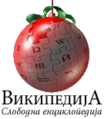利用者:Tomomarusan/sandpit
装飾品
[編集]あいさつ同好会(仮)
[編集]
|
この利用者はあいさつ同好会(仮)のメンバーです。 |
<div style="float:left;border:solid #bc6d06 1px;margin:1px">
{| cellspacing="0" style="width:238px;background:#f3d793"
|style="width:45px;height:45px;background:#f7bd06;text-align:center;font-size:12px"|[[Image:WikiThanks.png]]
|style="font-size:8pt;padding:4pt;line-height:1.25em"|この利用者は[[Wikipedia:あいさつ同好会 (仮)|<font color="tomato"><u>'''あいさつ同好会(仮)'''</font></u>]]のメンバーです。<div style="float:right;"><small>[[利用者:Tomomarusan|Ⓟ]]</small></div>
|}
</div>
ウィキ愛
[編集]
*お持ち帰りになる際は、こちらに一言お入れ下さい。彼がちょっと喜びます。
QRcode Wikipedia
[編集]
写真メモ
[編集]- ピンボケ 資料写真を求める方にとって、拡大して表示したらピンボケでしたというのは、大きな失望につながる。
方言メモ
[編集]- 西播磨と東播磨 播州弁といえど播磨は広く非常に小さくではあるが、大きく播磨を東西に分けた場合、播州弁にも主に東西で差異が存在する。最たる例としては西播磨では語尾に「~け」をつけることである。東播磨で「そぉこぉ」(そうですか)・「~しとるん?」(~しているの?)と言うところを、西播磨では常習的に「そぉけ・そないけ」・「~しとんのけ?・~してるんけ?」などと言う。その境界は播磨の地方区分とはやや異なっており、南は加古川と姫路の市境で、北は加西の丘陵地と加古川沿岸もしくは西脇との市境ではっきりと区分できる。例えば
- 「~ばい」が割と長崎弁に特徴的な言い方だが、強調するときの言い方。今時はもう少し軽く「~とさねー」くらいの言い方をする若者が多い。 語尾<「~と」「~ばい」が基本だが、しゃべり言葉では「~とさね」とか「~とね」とかもよく使う。「~とです」とかの丁寧な言い方も。島原方面なら「しちょるばい」。
- 名古屋弁・三河弁 こんばんは。そういえば音羽町のお年寄りが「のん」を時々使ってました。若い人は「じゃん・だら・りん」しか使わないので「だらぁ」にしてしまいました。(方言バベルページより)
- あげる(吐く)うら(後ろ) えらい(しんどい・苦しい) けつまづく(つまづく) すえる(腐るく)ちったあ(少しは) まっと(もっと)えーせーでー
*西部方言(沙流,鵡川,千歳) *東部方言(十勝,釧路,阿寒) *中部方言(北部方言(旭川等)) *日高東部方言(浦河,様似等) *樺太方言(サハリン) *千島方言(千島列島) * 北海道方言 ** 北東部方言 *** 北部(宗谷) *** 中部(天塩、石狩) *** 東部(十勝、北見、釧路、日高東部) ** 南西部方言 *** 南部(日高西部、胆振東部) *** 西部(後志) * 樺太方言(サハリン) * 千島方言(千島列島)
日本語族(にほんごぞく、Japonic languages)は言語の分類の一つであり、日本語および琉球語を含む。
現在のところ日本語及び琉球語はお互いが日本祖語というべき言語から分かれた兄弟の関係にあること以外では、明確には世界中のどの他の言語との親戚関係も明らかにはなっていない。(日本語の起源参照)
そこでひとまず日本語と琉球語の関係に注目してこれらを一つの語族と見なせばよいという考え方により、日本語族という呼び方が生まれた。
語派
[編集]日本語派(にほんごは)は日本語族の中で琉球語派を含まない、本州・四国・九州・北海道などで話されている「いわゆる日本語」のことである。
多くの方言を含むが、大まかに東日本方言と西日本方言、九州方言に分けられる。
- Japanese languages (日本語)
- Eastern Japanese (now represented only partially by the speech of Aogashima, Tokyo; Hachijojima, Tokyo; Minamidaito, Okinawa; Kitadaito, Okinawa; and a few other small islands)
- Western Japanese (represented by all Mainland Japanese dialects)
琉球語派
[編集]- 琉球語
- 奄美語
- 沖縄語
- 宮古語
- 八重山語
- 与那国語
- Ryukyuan languages (琉球語)
- Amami (奄美語)
- Okinawan (沖縄語)
- Kunigami dialect (or Northern Okinawan)
- Ie dialect
- South-Central dialect (or Standard Okinawan)
- Mainland dialect
- Shimajiri dialect (the linguistic affiliations of the Shimajiri dialects are uncertain, but are often included in the Southern dialect because the Shimajiri region is often considered to be part of that region)
- Miyako (宮古語)
- Yaeyama (八重山語)
- Yonaguni (与那国語)
Japonic languages
[編集]The Japonic languages are a language family believed to descend from a common language known as Proto-Japonic.
Origins
[編集]There is no universally-accepted concrete proof of the relationship between Japonic languages and other languages, but there are a variety of theories each backed up with a varying degree of scientific evidence.
- Japonic languages are a member of the Altaic language family. Other languages in this group include Mongolian, Tungusic, Turkish, and (according to most proponents) Korean. Evidence for this theory lies in the fact that like Turkish and Korean, Japanese is an agglutinative language.
- Japonic languages are a creole language. Phonological similarities and geographical proximity to Austronesian languages have led to the theory that Japanese may be a kind of creole, with an Altaic substratum and an Austronesian superstratum, or vice versa.
- Japonic languages are related to the extinct language of ancient Goguryeo in Korea. Some go further to include both Japonic and Goguryeo in a larger hypothetical language family called the Fuyu languages that would also include scarcely-attested extinct languages associated with ancient Fuyu and Baekje.
- Japonic languages are related to modern Korean based primarily on near-identical grammar, but there is scarce lexical similarity between the two; supporters of the Fuyu languages theory generally do not include modern Korean as part of that family.
As far as lexical studies have shown, the modern living non-Japonic language with the closest lexical similarity to any of the Japonic languages is Uyghur, a Turkic language.
In the wake of these theories, some argue that the similarity between all these languages is merely a sprachbund, and that the attested similarities between some or all of these languages are simply the result of their cultures being close geographic neighbors on the Asian mainland over the course of millennia.
External links
[編集]
資料(文書)
[編集]利用者‐会話:Sheynhertz-Unbayg 利用者:みっち/Tobeyさんのブロック問題について 利用者:Maris stella/百科事典とは何か 利用者:Electric goat/uua nekosuki


























